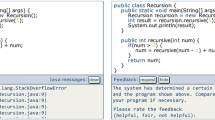Abstract
One of the things that is lacking in the relatively young field of Artificial Intelligence and Education is a good framework for describing and designing Intelligent Tutoring Systems (ITS). From literature, an agreed upon architecture seems to emerge, consisting of three or four experts: A Domain Expert, a Student Expert, a Teaching Expert, and often an Interface or Presentation Expert. This framework works well for describing existing systems in general terms, but as soon as one dives somewhat deeper or wants to use it for designing a new system, problems arise. The forms of expertise turn out to overlap, and the interfaces between them are unclear.
In this paper I describe a new conceptual framework for considering ITSs, consisting of three levels of problem solving loops: (1) A Curriculum level, (2) a Task level, and (3) a Discourse level. At each level potentially three processes take place: the Planning of actions to achieve some goal, the Monitoring of the execution of these actions (the performance), and the Diagnosing of possible errors in the execution. After a global description, I illustrate it by using it to describe two systems I have been involved in: the EUROHELP system, which actually is a shell for building Intelligent Help Systems for interactive computer programs; and the FysioDisc system, a coaching system for physiotherapeutic diagnosis. One of the advantages of the framework and the existence of well described interfaces between levels has already been demonstrated clearly by the porting of the entire communication level of the Eurohelp system to the FysioDisc system.
Preview
Unable to display preview. Download preview PDF.
Similar content being viewed by others
6 References
Anderson, J.R. & Reiser, B.J. (1985a). The LISP Tutor. Byte, April 1985, pp. 159–175.
Anderson, J. R., Boyle, C.F. & Yost, G. (1985b). The Geometry Tutor. Proceedings of the 9th International Conference on Artificial Intelligence, Los Altos, Kaufmann, pp. 1–7.
Breuker, J.A., Winkels, R.G.F. & Sandberg, J.A.C. (1986). Didactic Goal Generator. Deliverable 2.2.3 of the ESPRIT Project P280, ‘EUROHELP'. University of Amsterdam.
Breuker, J.A., Winkels, R.G.F. & Sandberg, J.A.C. (1987). A Shell for Intelligent Help Systems. Proceedings of the 10th International Joint Conference on Artificial Intelligence, 1, pp. 167–173.
Breuker, J.A. & Wielinga, B.J. (1989). Models of expertise in Knowledge Acquisition. In: G. Guida & C. Tasso (eds). Topics in Expert System Design: Methodologies and tools. North Holland, Amsterdam.
Breuker, J.A., Duursma, C., Winkels, R.G.F. & Smith, M. (1989). Knowledge Representation in Eurohelp: Modelling operation and understanding of computer applications for Help Systems. Proceedings of the ESPRIT Conference 1989.
Burton, R.R. (1982). Diagnosing bugs in a simple procedural skill. In: D. Sleeman & J.S. Brown (eds): Intelligent Tutoring Systems. New York: Academic Press.
Charniak, E. & McDermott, D. (1985). Introduction to Artificial Intelligence, ch 9. Addison-Wesley Publishing Company.
Clancey, W.J. (1986). Qualitative Student Models. Annual Reviews Computer Science, vol. 1, pp 381–450.
Clancey, W.J. (1987). Methodology for Building an Intelligent Tutoring System. In: G.P. Kearsley (ed). Artificial Intelligence & Instruction. Applications and Methods. Addison-Wesley, pp. 193–227.
Cohen, P.R. & Feigenbaum, E.A. (1982). Handbook of Artificial Intelligence, Vol III. Pitman Books.
Goldstein, I.P. (1979). The Genetic Graph: a representation for the evolution of procedural knowledge. International Journal of Man-Machine Studies, 11, pp. 51–77.
de Greef, P. & Breuker, J.A. (1989). A methodology for analysing modalities of system/user cooperation for KBS. Proceedings of EKAW '89, Paris, pp. 462–473.
Mandl, H. & Lesgold, A. (eds), (1988). Learning Issues for Intelligent Tutoring Systems. Springer Verlag, New York.
Murray, W. (1989). Control for Intelligent Tutoring Systems: A Blackboard-based Dynamic Instructional Planner. In: Proceedings of the 4th International Conference on AI & Education, IOS, Amsterdam, pp. 150–168.
Pirolli, P. & Russell, D. (1988). Towards Theory and Technology for the Design of Intelligent Tutoring Systems. Proceedings of the International Conference on Intelligent Tutoring Systems, Montréal, pp. 350–356.
Polson, M.C. & Richardson, J.J. (eds), (1988). Foundations of Intelligent Tutoring Systems. Lawrence Erlbaum Associates, Hillsdale.
Ross, P., Jones, J. & Millington, M. (1986). User Modelling in Intelligent Teaching and Tutoring. In: R. Lewis & E.D. Tag (eds). Trends in Computer Aided Education. Oxford: Blackwell.
Self, J. (1989). The Case for Formalising Student Models. Invited lecture at the 4th International Conference on AI & Education, May 1989, Amsterdam.
Soloway, E., Woolf, B., Rubin, E. & Barth, P. (1981). MENO-II: An Intelligent Tutoring System for Novice Programmers. Proceedings of the 7th International Joint Conference on Artificial Intelligence, Vancouver, pp. 975–977.
Tate, A. (1985). A Review of Knowledge-based Planning Techniques. In: M. Merry (ed). Expert Systems 85. Cambridge University Press.
Wenger, E. (1987). Artificial Intelligence and Tutoring Systems. Morgan Kaufmann, Los Altos.
Winkels, R.G.F. (1989). FysioDisc: An Intelligent Coaching System for Physiotherapeutic Diagnosis. In: De Moor, G. (ed). Readings in Medical Informatics. M.I.C. '89 Proceedings, pp. 295–301.
Winkels, R.G.F., Breuker, J.A. & Sandberg, J.A.C. (1988). Didactic Discourse in Intelligent Help Systems. Proceedings of the International Conference on Intelligent Tutoring Systems, Montréal, pp. 279–285.
Winkels, R.G.F., Achthoven, W.F. & Gennip, A. van (1989). Methodology and Modularity in ITS design. In: Proceedings of the 4th International Conference on AI & Education, IOS, Amsterdam, pp. 314–322.
Winkels, R.G.F. & Breuker, J.A. (in press). Discourse Planning in Intelligent Help Systems. In: C. Frasson & G. Gauthier (eds). Intelligent Tutoring Systems: At the Crossroads of Artificial Intelligence and Education. Ablex, NJ, Chapter 6.
Author information
Authors and Affiliations
Editor information
Rights and permissions
Copyright information
© 1990 Springer-Verlag Berlin Heidelberg
About this paper
Cite this paper
Winkels, R. (1990). A new framework for describing and designing intelligent tutoring systems. In: Mařík, V., Štěpánková, O., Zdráhal, Z. (eds) Artificial Intelligence in Higher Education. Lecture Notes in Computer Science, vol 451. Springer, Berlin, Heidelberg. https://doi.org/10.1007/3-540-52952-7_29
Download citation
DOI: https://doi.org/10.1007/3-540-52952-7_29
Published:
Publisher Name: Springer, Berlin, Heidelberg
Print ISBN: 978-3-540-52952-1
Online ISBN: 978-3-540-47183-7
eBook Packages: Springer Book Archive




